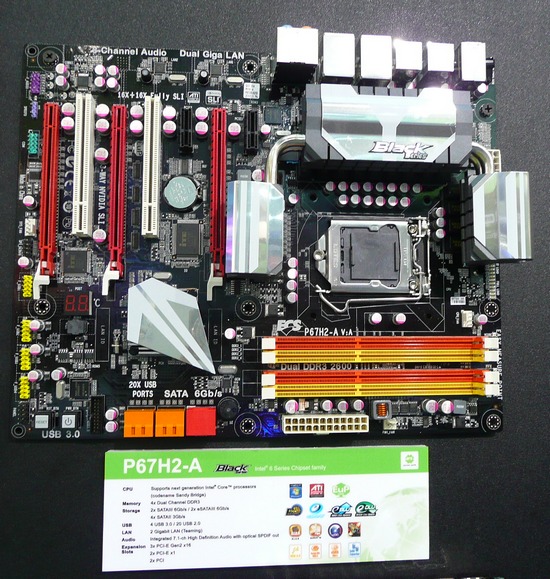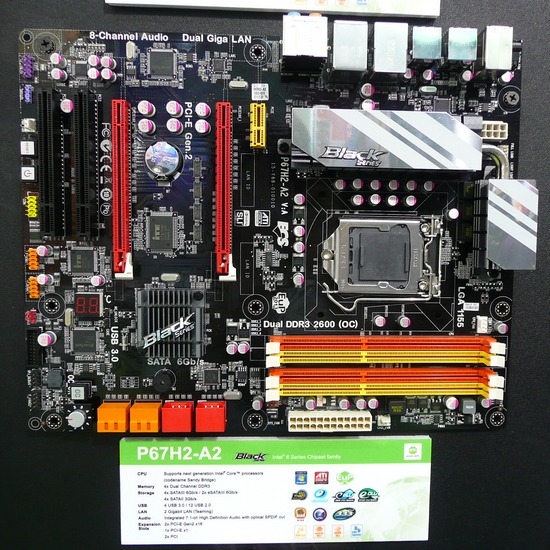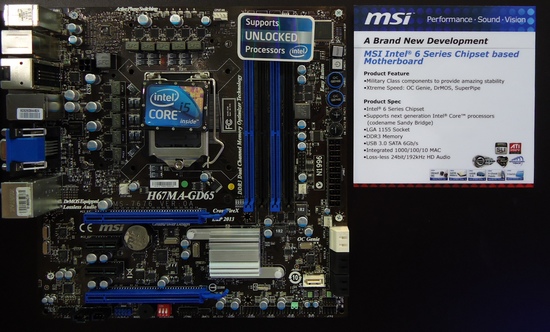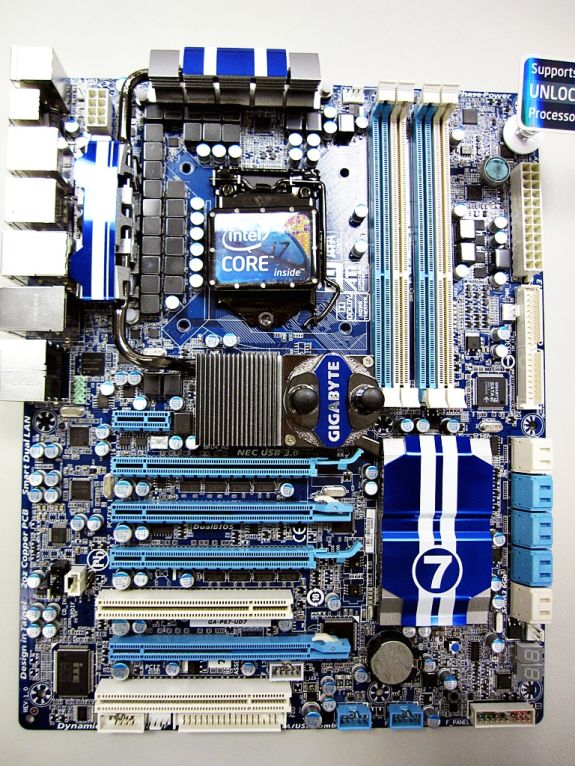Computex 2010: Motherboards
by Ian Cutress on June 16, 2010 12:36 PM EST- Posted in
- Trade Shows
- AMD
- Intel
- Motherboards
Even though Sandy Bridge is at least another 6 months away (if not Q4 2010 then H1 2011), motherboard manufacturers cannot wait to show off their concept design goodies. We've selected a few worthy of your attention.
ECS P67H2-A + P67H2-A2
Of the three 1155 boards at Computex from ECS, the P67H2-A represents their flagship model, and is slated to have four DDR3-2600 slots, 2x SATA 6Gb/s, 2x USB 3.0, 20x USB 2.0 (that's right, twenty!), dual Gigabit Ethernet and three PCIe Gen 2.0 slots. The layout does benefit tri-GPU users and part-time folders in terms of cooling.

For dual or single GPU users however, the P67H2-A2 looks the better mainstream board - more SATA ports, with four being SATA 6Gb/s, and an overclocking knob. From 0-9, ECS state that each notch will increase an overclock by 5%, meaning a possible 45% overall overclock. ECS won't let on if this is pure base clock increasing, or is coupled with voltage increases and suitable RAM clocking, but we wonder if they missed a trick, by not putting it all the way to 11.

MSI H67MA-GD65
Now that a significant proportion of the motherboard market is geared towards smaller motherboards of the micro-ATX and mini-ITX variety, manufacturers are already putting resources into their smaller form factor products - and as a result, MSI had a concept micro-ATX board based on the H67 chipset on display at Computex.

Featuring USB 3.0, SATA 6Gb/s and back panel HDMI/DVI-D/D-Sub connectors, as well as an array of Power/Reset/Clear CMOS/OC Genie board buttons, the two x16 PCIe Gen 2.0 ports are set three slots apart rather than two, allowing better cooling opportunities, but at the expense of a lot of USB headers if long dual slot cards are used.
Gigabyte P67-UD7
Recent X58 policy with Gigabyte has been to add water cooling into the heatpipe system, chuck in a few hundred phases (or at least 24), and plug the board full of PCIe slots - as seen with the X58A-UD7 and X58A-UD9. Well this time, they're preparing at least one socket 1156 version, possibly in time for Sandy Bridge release.
There has been some confusion online as to whether this board is the UD7 or the UD9 with a massive '7' on the board and in UD7 livery. Apart from getting our image direct from Gigabyte, for comparison with the X58 lineup, the UD7 has two PCI slots, whereas the UD9 does not have any. Perhaps the words 'UD9' light up certain enthusiasts’ eyes, as well as dollar signs in those of Gigabyte executives.











33 Comments
View All Comments
LoneWolf15 - Wednesday, June 16, 2010 - link
"ECS are desperately trying to break into consumer markets,"If they hadn't made nearly a decade of budget, sometimes complete garbage mainboards, I might consider them. Their past (some of it not that long ago) kills that.
Even good boards on paper, like the vaunted K7S5A some years back, were plagued by quality control issues during manufacturing, furthering this perception. I saw way too many ECS RMAs. The fact that they haven't stopped making cheapo mainboards either also dilutes the brand.
If ECS wants to succeed with the consumer or enthusiast market, they should create a new division dedicated to the quality gear, with a new brand name. Otherwise, their brand will continued to be marred by their low-end stuff, discouraging people from buying at the high-end.
jaydee - Wednesday, June 16, 2010 - link
I bought a K7S5A new and it was quite a board for the money at the time (I sold the system to a friend, as far as I know it's still running). I know they don't have the best rep, but based on that one experience I've had with them, I'd have no problems going with them again. That being said, I've never been in the market, nor ever see myself going for top-end enthusiast boards (by any maker). But for a low-end, middle of the road, I'd trust ECS.Samus - Wednesday, June 16, 2010 - link
Most of the problems ECS boards I ran into had were directly related to the use of VIA chipsets. The K7S5A was an exception to their poor quality because it was an SIS chipset which was undeniably more stable than VIA's competing chipsets and had far less IDE bugs. There was a great DMA patch SIS released to solve performance problems as well that worked like a charm.ECS boards based on nVidia and Intel chipsets have been equally as good as the SIS-based K7S5A. It's VIA that really tarnished their rep. When you look at the other brands from the VIA-era, in the end, they were all garbage. Few of them lasted more than a couple years before burning out or blowing caps. They were arguably never really stable. To pour salt on the wound, ECS traditionally used VIA's reference designs, too.
I've had good experience with ECS' Intel-based boards. Except for the crappy BIOS support.
MrSpadge - Wednesday, June 16, 2010 - link
Can't really blame the chipset for blowing caps, can you?Operandi - Thursday, June 17, 2010 - link
I've built tons of systems around VIA chipsets and never had problem with stability or reliability. In fact a couple of them have been running 24/7 since I built them in 01 - 02.The chipsets were solid and reliable if not performance leaders, stability and longevity is up to the motherboard manufacture building a good board. In fact I've seen more dead motherboards based on Intel chipsets than I have VIA based boards.
Redcharlie - Thursday, June 24, 2010 - link
I bought a K7S5A new on Sept 11, 2001, and it ran well for years, although I did have to update the BIOS to use a 160GB drive. It was a great board at a great price. I finally replaced it in 2008.Since buying the K7S5A I've bought boards from DFI, Gigabyte, and Asus, but have never seen a particular ECS board that stood out enough to tempt me. Glad to see them back in the ring.
chrnochime - Wednesday, June 16, 2010 - link
Well my crappy ECS board that has Nvidia 6150 chipset that I got from Fry's with the E2200 has seen the CPU oc'd to 2.9GHz, been on for at least 5 hours each day, for the last 2 years without any hardware problem or BSOD in windows vista. That cobbled together rig is actually much more stable than the one I put together as a temp HT/game PC with the Asus P5q pro and E8400, which thus far has encountered a bunch of random BSOD. Might have something to do with me using the Ati Tray Tool in Vista for the 4870, but then the same setup worked with the ECS board with no problem at all.bji - Wednesday, June 16, 2010 - link
What a blast from the past. And present, I suppose - I bought an ECS K7S5A in 2002 and it performed very well for me. In fact, it is still going strong in that computer, which I gave to my mom in 2005, and which she still uses daily (with an Athlon XP 1800+). I really need to put together a new computer for my mom ...Death666Angel - Thursday, June 17, 2010 - link
Hehe, just wanted to say that I owned a K7S5A with a 1800+ XP iirc. I had a great time with the board, never any problems, had my CPU overclocked with some silver paste and it ran as a 2200+. :D But I knew then that I was one of the few lucky ones and today I wouldn't go for them anymore, I'm a strong Gigabyte fan for overclocking and MSI for some budget boards. Asus let me down with my Q6600....cactusdog - Wednesday, June 16, 2010 - link
ECS need to improve their after sales if they want to sell performance boards. If a new CPU or component comes out ECS wont update the bios so users are stuck with no upgrade path.